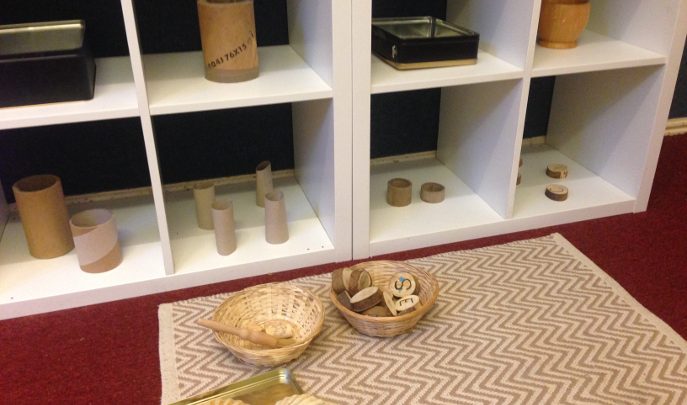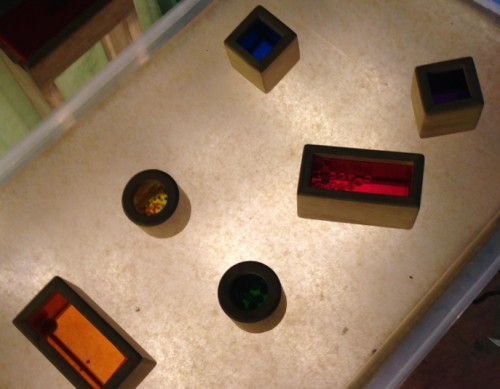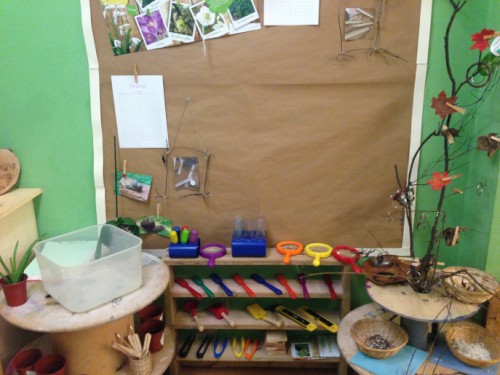3 Ideas For Early Years – Introducing A Nature Station, A Homemade Light Box And Heuristic Play

Laura England heads into space to explore light and dark, discovers children’s interests through heuristic play, and adds inspiration to her exploration area

Recently, we introduced heuristic play sessions for our 0-2-year-olds; during each the session children are given the opportunity to explore a range of natural and found materials, including shells, tubes, tins, wooden utensils and tubs.
Adults sit to one side throughout the session, closely observing the way in which the children use the objects provided, with as little interaction as possible. We have found many benefits to the sessions, not least that they have given us a chance to deeply understand what the children’s interests are – which in turn has allowed us to set up provocations and activities built on our understanding of their play.
One little boy continually dropped a metal bangle into a metal tin, watching it spin. After a couple of minutes, he threw a wooden bangle into the metal tin, again watching it spin. After the session, we were able to build on this by providing similar items to test out, deepening his levels of understanding!
Light and dark
 Over the past few weeks we have been exploring light and dark, and, subsequently, space. We started with a home-made light box (a plastic box lined with white tissue paper, filled with fairy lights), followed this by using torches to create shadows, which then led on to making glow-in-the-dark sensory bottles.
Over the past few weeks we have been exploring light and dark, and, subsequently, space. We started with a home-made light box (a plastic box lined with white tissue paper, filled with fairy lights), followed this by using torches to create shadows, which then led on to making glow-in-the-dark sensory bottles.
We made black-and-white patterns, explored writing on black paper with white chalks and vice versa. We created ‘moon dust’ by exploring different materials, finally settling on crushed chalks, which we made footprints in. We counted stars, explored planets and used technology to look at what was in space, above us.
We created aliens, explored slimy textures, made up silly words and dressed up as astronauts. We made a spaceship and watched the first moon landing in it; we flew it all around the garden and collected moon rocks – all because one little boy said, “Isn’t the sky dark…”
Nature station
 I have a very well-resourced exploration area, which contains lots of natural objects and instruments for exploration, including magnifying glasses, test tubes, digging tools, tweezers, scales and torches. Unfortunately, this area has often been lacking in inspiration for both the children and me – while it always looks rather impressive, it’s not always doing a lot that could be described as impressive!
I have a very well-resourced exploration area, which contains lots of natural objects and instruments for exploration, including magnifying glasses, test tubes, digging tools, tweezers, scales and torches. Unfortunately, this area has often been lacking in inspiration for both the children and me – while it always looks rather impressive, it’s not always doing a lot that could be described as impressive!
So, to try to take advantage of the children’s interests I added an inspiration board, filled with posters and pictures all about planting and bug habitats. Now we have branches to hang our natural findings on, and we even have a box which we will eventually fill with snails – the children have been hunting for one but, as of yet, we don’t have a classroom pet!
This area has now become very popular as the children bring nature indoors, to explore, draw and add to creative pieces. Next up is planting indoor plants!
Laura England is preschool leader at Blythe Bridge Day Nursery. Follow @littlemiss_ey











